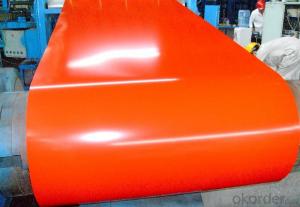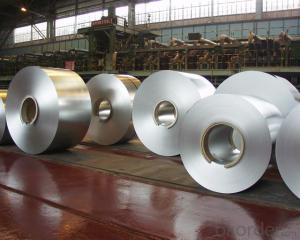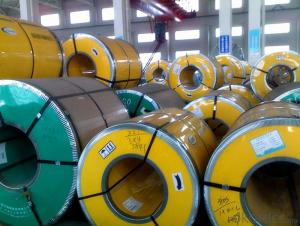Hot-dip Aluzinc Steel Building Roof Walls 615-009-01
- Loading Port:
- Tianjin
- Payment Terms:
- TT OR LC
- Min Order Qty:
- 66 kg/m²
- Supply Capability:
- 11 kg/m²/month
OKorder Service Pledge
OKorder Financial Service
You Might Also Like
. Description of the Hot-dip Aluzinc Steel:
Hot-dip aluzinc steel structure is composed of aluminum-zinc alloy, consisting of 55% aluminum, 43% zinc and 2% at 600 ℃ silicon solidification temperature and composition, the entire structure is made of aluminum - iron - silicon - zinc, to form a dense quaternary crystals an alloy.
Hot-dip aluzinc steel has many excellent features: strong corrosion resistance, is three times the pure galvanized sheet; zinc surface with beautiful flowers, can be used as a building outside board.
Applications of hot-dip aluzinc steel:
1)Building: roof, walls, garages, soundproof walls, pipes and modular housing.
2)Automotive: muffler, exhaust pipes, wiper accessories, fuel tank, truck boxes, etc.
3)Appliances: refrigerator back, gas stove, air conditioners, microwave oven, LCD frame, 4)CRT-proof band, LED backlight, electrical cabinets, etc.
5)Farm: barn, sheds, silos, piping and other greenhouse.
6)Other: breaking heat insulation cover, heat exchangers, dryers, warm water, etc.
Although steel had been produced in bloomery furnaces for thousands of years, steel's use expanded extensively after more efficient production methods were devised in the 17th century for blister steel and then crucible steel. With the invention .
2.Main Features of the Hot-dip Aluzinc Steel:
• Excellent corrosion resistance
• High temperature oxidation resistance
• High hot reflectance
• Good manufacturability
•Beautiful appearance
•Surface coating
•Cost-effective
3.Hot-dip Aluzinc Steel Images

4.Hot-dip Aluzinc Steel Specification
AVAILABLE SPECIFICATION
HOT-DIP ALUZINC STEEL COILS | |
THICKNESS | 0.16mm-3.5mm |
WIDTH | 1250mm MAX |
COATING MASS | |
SPANGLE | Regular Spangle, Minimized Spangle, Zero Spangle |
SURFACE TREATMENT | Chromated / non-chromated, Oiled / non-oiled, Anti Finger Print |
COIL INNER DIAMETER | 508mm or 610mm |
5.FAQ of Hot-dip Aluzinc Steel
We have organized several common questions for our clients,may help you sincerely:
1.What advantages does your company have?
Cement : Annual capacity of 400 million tons, No. 1 in the world
Fiberglass: Annual capacity of 1 million tons fiberglass, No. 1 in the world.
2.What advantages do your products have?
Firstly, our base material is of high quality, Their performance is in smooth and flat surface,no edge wave ,good flexibility.
Secondly, high quality zinc ingoats, 97.5% zinc,1.5% silicon,1% others, the same zinc coating measured by metal coating thickness or by zinc weight
Thirdly, high precision: Tolerance strictly according to ASTM or JISG standard even more rigid.
We have full stes of testing equipment(for t best, cupule,chromatism,salt spray resistance, etc) and professional engineers.
3.Could you let me approach about your company in Dubai?
Located at Jebel Ali Free Zone in Dubai, CNBM Dubai Logistics Complex is adjacent to -Jebel Ali sea port-the largest port in UAE and Al Maktoum Airport-
- Q:What are the dimensional inspection methods for steel strips?
- Steel strips commonly undergo dimensional inspections using various methods to ensure their accuracy and conformity to specified standards. Some commonly employed methods for this purpose include: 1. Calipers: These instruments directly measure the thickness, width, and length of steel strips by comparing them with the calibrated scale on the caliper. This provides precise measurements. 2. Micrometers: Precision instruments like micrometers accurately measure the thickness and width of steel strips, even up to the micrometer level. They offer highly accurate measurements. 3. Optical comparators: By magnifying and illuminating the steel strip, optical comparators enable a visual comparison with a reference standard. This method allows the inspection and measurement of dimensions like width, length, and shape. 4. Laser measurement: Laser measurement systems utilize laser beams to accurately measure dimensions such as width, thickness, and more without physical contact. This ensures high precision and speed. 5. Coordinate measuring machine (CMM): CMMs are automated and highly precise dimensional inspection methods. They utilize a probe to measure multiple dimensions, including length, width, thickness, and complex geometries. CMMs provide accurate measurements for various steel strip profiles. 6. Vision systems: Vision systems incorporate cameras and image processing algorithms to inspect dimensions like width, length, and thickness of steel strips. They can also detect surface defects or irregularities. These dimensional inspection methods are often used in combination to obtain comprehensive and accurate measurements of steel strips. The selection of the appropriate method depends on the specific requirements, desired accuracy, and the type of steel strip being inspected.
- Q:What is the length tolerance of steel strips?
- The length tolerance of steel strips can vary depending on the specific type and grade, but generally it is around ± 0.2% to ± 0.5% of the specified length.
- Q:What are the different methods for etching steel strips?
- Etching steel strips can be done in various ways, each with its own advantages and uses. Some commonly employed methods are as follows: 1. Chemical etching: This method is widely used and involves immersing the steel strip in a chemical solution, usually an acid. The acid selectively removes the metal to create the desired pattern or design. Chemical etching allows for high precision and intricate designs, making it suitable for decorative items, nameplates, and electronic components. 2. Laser etching: Laser etching utilizes a high-powered laser beam to remove material from the steel strip. It is a highly precise method and can create detailed designs, logos, or text on the strip's surface. Industries like automotive, aerospace, and electronics frequently employ laser etching for marking and branding purposes. 3. Electrochemical etching: Also known as electrolytic etching, this method employs an electric current to remove metal from the steel strip. The strip is immersed in an electrolyte solution, and a stencil or mask is placed on its surface. When a current is applied, metal ions dissolve in the electrolyte, resulting in etching. Electrochemical etching is commonly used for creating permanent markings, such as serial numbers, on steel strips. 4. Photochemical etching: This method involves applying a photosensitive resist to the steel strip. A photographic negative or mask is then placed on top of the resist, and the strip is exposed to light. The exposed areas harden, while the unexposed areas remain soft. The soft areas are subsequently washed away, leaving behind the desired pattern. Photochemical etching finds applications in high-precision etching, such as microelectromechanical systems (MEMS), printed circuit boards, and precision components. 5. Abrasive etching: This method entails using abrasive materials, like sandblasting or grit blasting, to physically remove metal from the steel strip. Abrasive particles are propelled at high speeds onto the strip's surface, eroding the top layer and creating the desired design or texture. Abrasive etching is often employed for decorative purposes, such as achieving a matte or textured finish on steel strips. These represent just a few of the numerous methods available for etching steel strips. The choice of method depends on factors such as the desired design, precision requirements, production volume, and the specific application of the steel strip.
- Q:What are the different bending methods for steel strips?
- There are several different bending methods for steel strips, including cold bending, hot bending, roll bending, and press bending. Cold bending involves bending the steel strip at room temperature, typically using a press brake or similar equipment. Hot bending, on the other hand, involves heating the steel strip to a specific temperature before bending it. Roll bending is a method where the steel strip is passed through a series of rollers to achieve the desired shape. Finally, press bending involves using a hydraulic press to bend the steel strip into the desired form.
- Q:What are the different surface laminating options for steel strips?
- There are several surface laminating options for steel strips, including hot-dip galvanizing, electroplating, powder coating, and painting.
- Q:How are steel strips used in the manufacturing of transmission towers?
- Due to their inherent strength and durability, steel strips find extensive use in the production of transmission towers. These strips are typically crafted from high-quality steel alloys that possess exceptional mechanical properties, such as high tensile strength and corrosion resistance. In the manufacturing process, steel strips undergo initial cutting into specific lengths and subsequent shaping into the necessary sections of the transmission tower. These sections may encompass the primary vertical columns, horizontal cross-arms, and various bracing elements. By bending, folding, and welding the steel strips together, these structural components are formed, ensuring a sturdy and stable tower structure. Furthermore, steel strips also serve in the creation of baseplates and anchor bolts, which are vital for securely fastening the transmission tower to the ground. These components provide stability and support, guaranteeing the tower's ability to withstand the forces exerted by wind, ice, and other environmental factors. The utilization of steel strips in transmission tower manufacturing offers multiple advantages. Firstly, steel is renowned for its high strength-to-weight ratio, making it an ideal material choice to maintain the tower's structural integrity without adding excessive weight. This is crucial as transmission towers need to support heavy electrical conductors over long distances. Additionally, steel strips can be efficiently mass-produced, leading to cost-effective manufacturing processes. Steel's versatility allows for customization to meet specific design requirements, ensuring that transmission towers are tailored to fit the demands of various transmission line configurations. Moreover, steel's resistance to corrosion renders it suitable for outdoor applications, where transmission towers are constantly exposed to harsh weather conditions. This durability ensures that the towers have a lengthy lifespan and require minimal maintenance, thereby reducing operational costs. In conclusion, steel strips play a crucial role in transmission tower manufacturing by providing a robust, durable, and customizable material for various structural components. Their high strength, ease of fabrication, and resistance to corrosion make them an ideal choice for constructing reliable and long-lasting transmission towers.
- Q:Specification and use of cold rolled strip
- Cold rolled strip steel: widely used in construction machinery, transportation machinery, construction machinery, lifting machinery, agricultural machinery and light industry, civil and other general structural parts and stamping parts.
- Q:How are steel strips tested for surface roughness?
- Steel strips are tested for surface roughness using various methods and instruments. One common method is the use of a surface profilometer, which is a precision instrument that measures the height variations across the surface of the steel strip. The profilometer consists of a stylus or probe that is moved across the surface, and as it moves, it records the vertical movements or deviations. By analyzing the data collected by the profilometer, the roughness parameters such as Ra (average roughness) and Rz (mean peak-to-valley height) can be determined. Another method used for testing surface roughness is the use of a laser scanning system. This system utilizes a laser beam that is directed onto the steel strip surface, and the reflected laser light is captured by a sensor. The sensor detects any irregularities or changes in the reflected light, which can then be analyzed to determine the surface roughness. Additionally, visual inspection and touch methods may also be used to assess surface roughness. Skilled operators visually examine the steel strip for any visible roughness or irregularities, while the touch method involves running a gloved hand across the surface to feel for any rough spots or inconsistencies. Overall, steel strips are tested for surface roughness using a combination of advanced instruments, visual inspection, and touch methods to ensure that the desired quality standards are met.
- Q:How are steel strips protected against chemicals in industrial environments?
- Steel strips are protected against chemicals in industrial environments through the application of protective coatings or finishes. These coatings are designed to create a barrier between the steel surface and the chemicals, preventing direct contact and potential corrosion. Additionally, certain types of stainless steel or alloys with high resistance to chemical reactions may be used to enhance the overall durability and protection of the steel strips in such environments.
- Q:Can steel strips be used in food-grade applications?
- Yes, steel strips can be used in food-grade applications. They are often used in the manufacturing of food processing equipment, storage tanks, and conveyors due to their durability, resistance to corrosion, and ease of cleaning. However, it is crucial to ensure that the steel strips used are made of food-grade stainless steel to maintain hygiene and prevent any contamination risks.
1. Manufacturer Overview |
|
|---|---|
| Location | |
| Year Established | |
| Annual Output Value | |
| Main Markets | |
| Company Certifications | |
2. Manufacturer Certificates |
|
|---|---|
| a) Certification Name | |
| Range | |
| Reference | |
| Validity Period | |
3. Manufacturer Capability |
|
|---|---|
| a)Trade Capacity | |
| Nearest Port | |
| Export Percentage | |
| No.of Employees in Trade Department | |
| Language Spoken: | |
| b)Factory Information | |
| Factory Size: | |
| No. of Production Lines | |
| Contract Manufacturing | |
| Product Price Range | |
Send your message to us
Hot-dip Aluzinc Steel Building Roof Walls 615-009-01
- Loading Port:
- Tianjin
- Payment Terms:
- TT OR LC
- Min Order Qty:
- 66 kg/m²
- Supply Capability:
- 11 kg/m²/month
OKorder Service Pledge
OKorder Financial Service
Similar products
New products
Hot products
Related keywords




























